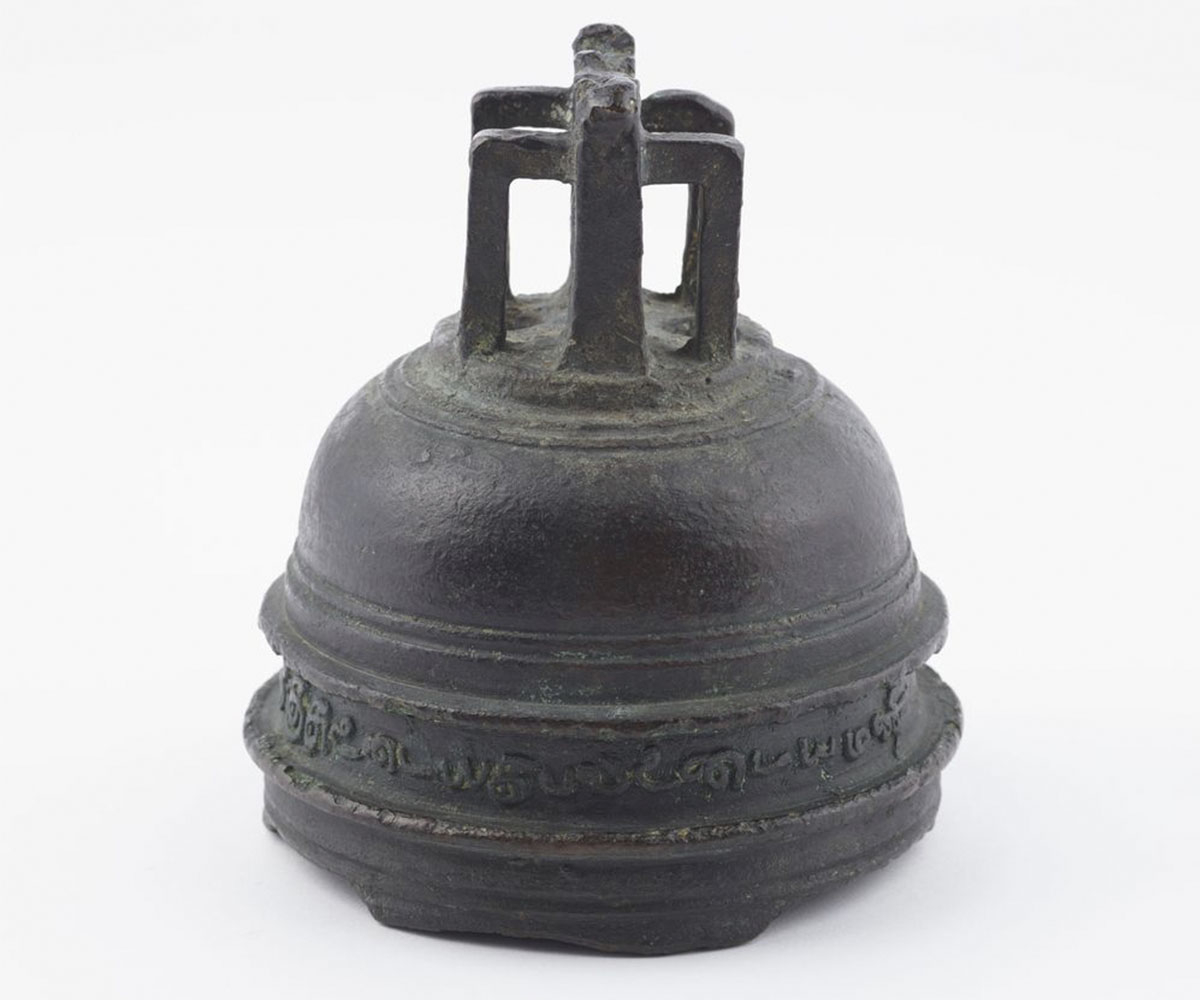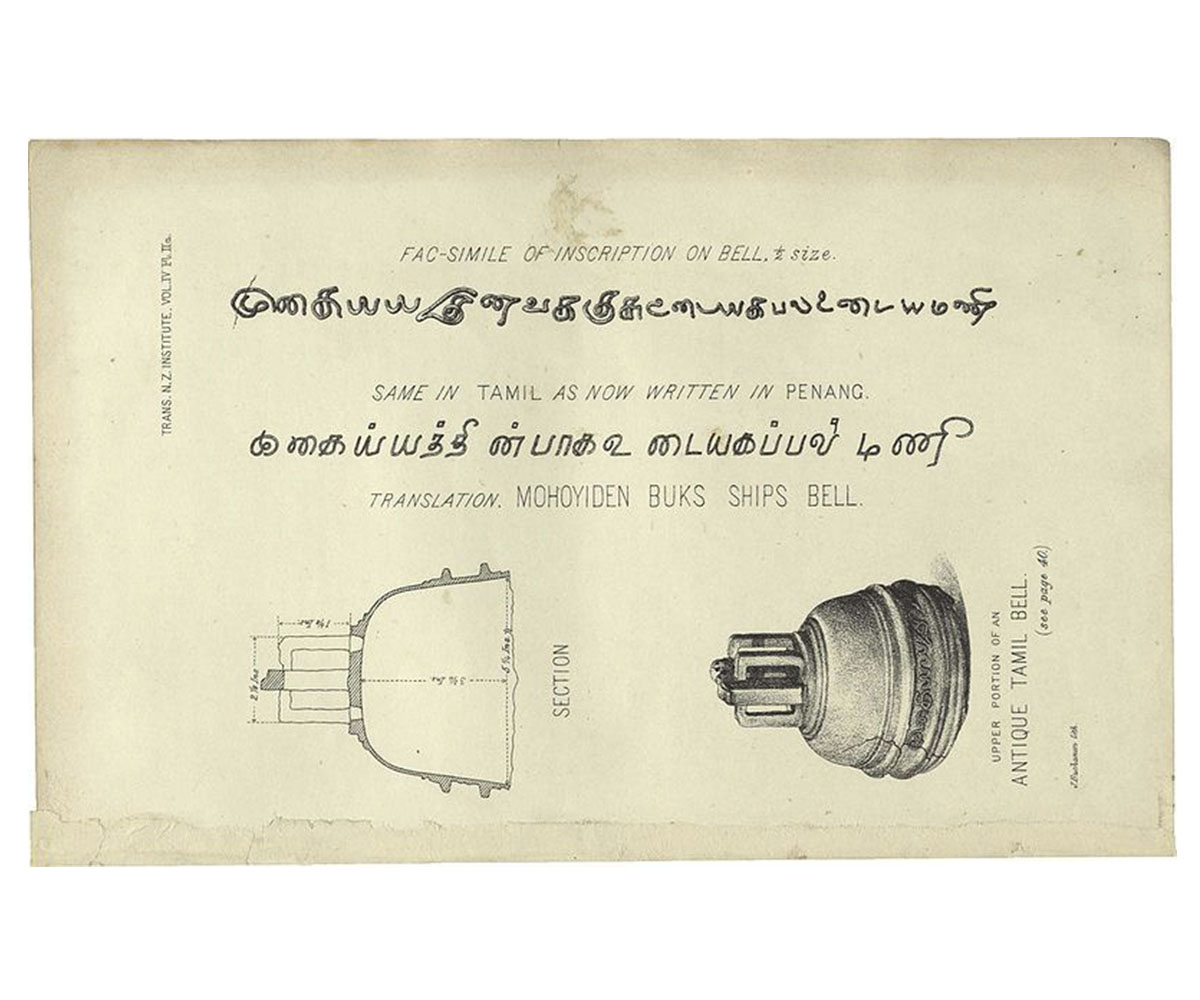ARTICLE
Tamil Bell
A partial ship’s bell made of bronze and bearing a Tamil inscription, the Tamil Bell, as it is commonly known, was discovered c. 1840 at a Maori village near Whangarei, in the northernmost part of New Zealand. Found with the clapper and the waist, or main shell, missing, only the topmost part of the bell survives. Comprising the bell’s crown and canons, the artefact is 16 centimetres high and 9 centimetres deep, with a 15-centimetre diameter, and weighs 2.6 kilogrammes. The inscription along the outside rim reads, in an archaic Tamil script, ‘Mohideen Baksh udiya kappal udiya mani’, which can be translated as ‘the bell of the ship of Mohideen Baksh’. Appearing in relief rather than engraved into the metal, the inscription is clear and well preserved, presumably protected from wear by the flanges or raised collars running along the crown above and below it.
William Colenso, a Cornish missionary, discovered the bell when he arrived at the village, reportedly the first European to visit there. He found it being used as a cooking vessel; it caught his attention because the region did not produce bronze at the time and was not yet engaged in foreign trade. The community informed Colenso that the ‘cooking pot’ had been in their possession for generations, having first been found among the roots of a tree uprooted during a storm. After Colenso gave the community an iron pot in exchange for the bell, it remained in his personal possession until his death in 1899. It was then bequeathed to the Colonial Museum (now the Museum of New Zealand or Te Papa Tongarewa) in Wellington.
Its unknown provenance has brought the Tamil Bell both scholarly attention and public curiosity. Until the bell’s discovery, there had been no records of Tamil trading ships visiting New Zealand, and it is unclear how the bell reached there from its point of origin — presumably a Tamil-speaking region of India, Sri Lanka or Southeast Asia. There has also been much speculation on what the bell’s inscription denotes.
Originally, scholars dated the bell to the fifteenth or sixteenth century and presumed that Mohideen Baksh had been the owner of the ship to which it belonged. They proposed that the ship might have been one among many Tamil trading vessels plying Arab trade routes during that period, and had drifted many thousands of kilometres towards Whangarei after becoming derelict or abandoned. Another theory suggested that the bell might have been a sailor’s lost souvenir from a Tamil ship or a port in South Asia. A similar theory outlined that the bell, originally taken to Spain from South Asia in centuries prior, may have made its way slowly to New Zealand with later generations of Spanish or Portuguese sailors as a memento or cultural artefact, around the middle of the sixteenth century.
More recent research focusing on the inscription, however, has led scholars to date the bell to a much later period — the seventeenth or eighteenth century — based on the evolution of the Tamil script over time. Records of shipping logs from this period have also revealed that many South- and Southeast Asian ships from the time were given the name Mohideen Baksh — invoking the protection of a saint of that name, who was revered by Muslim mercantile communities in these regions. This suggests that the bell may have belonged to one such vessel, with the inscription naming the ship itself rather than its owner.After the story of the Tamil Bell was published in a regional newspaper in Tamil Nadu, India in 1975, several families in the region claimed to be descendants of merchants who had possibly owned a ship named Mohideen Baksh, with some asking that the artefact be returned to the state. However, no such claims have been verified and the bell’s exact origins as well as its route to New Zealand remain unknown. It continues to be held in the collection of the Museum of New Zealand.
Bibliography
Hilder, Brett. “The Story of the Tamil Bell.” The Journal of the Polynesian Society 84, no. 4 (1975): 476–84. https://www.jps.auckland.ac.nz/document/?wid=4214.
Derrah, Petrina. “The Mystery of New Zealand’s Tamil Bell, an Archaeological ‘UFO’.” Atlas Obscura, February 8, 2023. Accessed March 16, 2023. https://www.atlasobscura.com/articles/tamil-bell-mystery-new-zealand
Museum of New Zealand Te Papa Tongarewa, “Ship’s Bell.” Accessed March 16, 2023. https://collections.tepapa.govt.nz/object/213397








